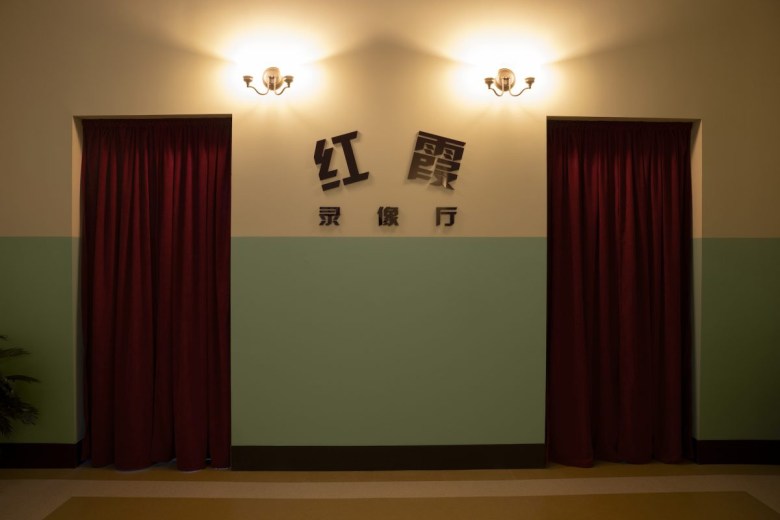SAVANNAH, Georgia — Stepping into the entryway of the galleries at the SCAD Museum of Art, I stand in a waiting area. Without the exhibition title and text affixed to one wall, one could pass through this space without a second thought. Yet this room — with glossy linoleum floors, a few weathered folding chairs, and a smattering of plants and signage, which recalls a Changchun line subway station in China — establishes the importance of transience and journeying throughout the ensuing exhibition. In recreating sites of industrialization and migration, Cao argues for caution when presented with grandiose proposals for the future.
Beyond a curtained doorway lie two video installations. “MatryoshkaVerse” (2022) is a two-part projection exploring Manzhouli, a city at the intersections of China, Russia, and Mongolia, and a nexus of cultural and physical exchange. When the Sino-Soviet Treaty was signed in 1950, exchange between China and Russia was seen as mutually beneficial, with the Russian Communist Party going so far as to invest in more than 100 different Chinese infrastructure projects. However, that unmitigated optimism waned. The film documents Chinese border guards installing new wire fences, workers interacting with defunct railway equipment, and the Russian government dedicating a monument to Russian soldiers who died fighting against “fascism in the Chinese theatre.” Much like the relations between China and Russia, at the conclusion of the film, the camera looks upward and spins until it spirals out of control.
The second installation consists of two films: “Nova” (2019) and “HongXia” (2020). The first is a fictitious drama about a time-traveling scientist, while the second documents the rapid development of electrical component factories in Jiuxianqiao in the 1950s. These factories were constructed under Soviet oversight and influence, pressuring the newly formed People’s Republic of China into an era of rapid technological development, which resulted in drastically improved working and living conditions. Thousands of Chinese people, many of them well-educated, flocked to these factories to become a part of this bright, new industry. However, as electrical technology continued to advance at an increasingly fast pace, they were soon producing out-of-date equipment, and the factory was subsequently shut down, leaving thousands unemployed and unhoused. The promise of a better tomorrow came and went in less than a generation’s time — yet the infrastructure it created remains. Much of the film documents former employees’ hopes and desires while revisiting the now-abandoned and crumbling buildings in which they once lived and worked. Although many possibilities for rehabilitation or reinvention of these sites are discussed, none have been enacted.
Viewed today, these works serve as a cautionary tale in the face of AI technologies. Newly publicized technologies present more expedient workflows, smarter software, and less stressful work lives, but ring with false sincerity when set upon Cao’s historical backdrop. While the widespread adoption of AI technologies may yield benefits, this exhibition asks us to consider how long those benefits may last, and what will remain after they’re gone. The photograph “MatryoshkaVerse 02” (2022), for instance, features four figures in a verdant field, each beneath a suspended matryoshka doll. The seeming unreality of the floating objects brings levity to the photograph, a delightful inversion of expectations. Yet, the scene is not entirely idyllic. The sky toward which the dolls ascend and look is overcast. The blue sky beyond is shrouded and obscured. Focus on the future is not to be discarded entirely, but recognition of its unknowability is mandatory.







Cao Fei: At the Edge of Superhumanity continues at Savannah College Art and Design Museum of Art (601 Turner Boulevard, Savannah) through July 29. The exhibition was curated by Brittany Richmond.

